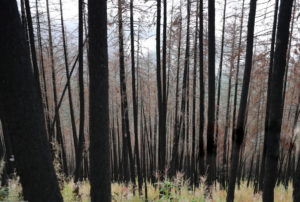Why use salvaged timber?
Posted: October 4, 2021What is salvaged timber?

What is the condition of the Western forests now?
Drought and wildfires were always a natural part of the Western forest, but due to fire suppression our forests have become very “unnatural.” We haven’t allowed Mother Nature to manage and regenerate our forests. We live in the forest and we naturally want to protect it, but our instinct to stop all fires hasn’t necessarily been a good thing for the long-term health of our trees. Without fires, our forests have become overgrown and crowded.
A healthy Western forest should have 40-60 trees per acre: Montana currently averages between 100-200. Due to drought and mismanagement, our trees are significantly stressed—40 trees per acre compete for the same water and soil nutrients as 200 trees per acre. Stressed trees are more susceptible to insect attack.
The mountain pine beetle has wreaked havoc across the Western United States, killing millions of acres of trees in the U.S. and Canada. These beetle-killed trees inevitably dry out and become fuel for catastrophic wildfires in the future. We would much rather get into the woods, take these dead trees out and make more room for the living. Of course, we would also like to see some of the living forests better managed for their health as well.
Why is salvaged timber considered to be of low economic value?
Salvaged dead standing trees are typically left to rot due to their low economic value for framing lumber. Milling dead timber is an art. There is a reason large commercial sawmills don’t like them. Unlike living trees, dead standing timber has significantly more defects like cracks, checks, splits, rot, and bug holes. We cut these trees into 8′ longboards, kiln dry them, and then run them through our molder to create reclaimed timber floorboards. After the boards are milled, we cut out all the defects and apply a tongue and groove on the ends so each board locks together nicely. All the defects and downfall fuel our boiler which heats our kiln, office, and shop. We literally waste nothing.
We think it’s worth the extra time it takes. Montana Doug Fir and Pine are very slow-growing trees. Due to high elevations and low humidity, our trees have a tremendous amount of rings per inch. We average 15-20 rings per inch compared to the 3-5 rings per inch for coastal trees.
We did some testing with the College of Forestry at Oregon State University. The feedback from our customers stating the amazing stability of our products prompted us to take a closer look at why. Oregon State took a sample of our wood and a piece of coastal Douglas Fir and dried both samples down to about 6% moisture content. They then slowly tried to bring the moisture content back up. Turns out our wood is significantly less prone to swelling compared to the coastal Fir.
